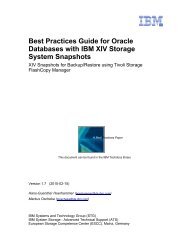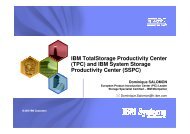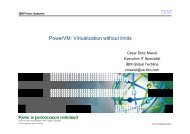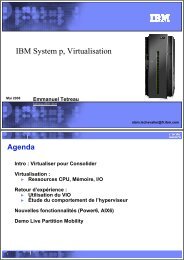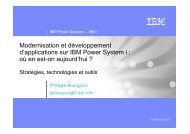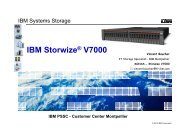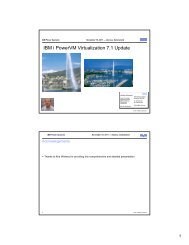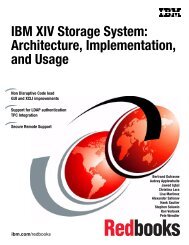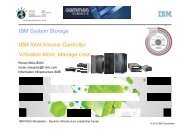IBM XIV Storage System Copy Services and Migration
IBM XIV Storage System: Copy Services and Migration - Common ...
IBM XIV Storage System: Copy Services and Migration - Common ...
- No tags were found...
You also want an ePaper? Increase the reach of your titles
YUMPU automatically turns print PDFs into web optimized ePapers that Google loves.
eceiving read requests from a host, when in fact it is the <strong>XIV</strong> <strong>Storage</strong> <strong>System</strong> doing ablock-by-block copy of the data, which the <strong>XIV</strong> is then writing onto an <strong>XIV</strong> volume.During the background copy process, the host server is connected to the <strong>XIV</strong> <strong>Storage</strong><strong>System</strong>. The <strong>XIV</strong> <strong>Storage</strong> <strong>System</strong> h<strong>and</strong>les all read <strong>and</strong> write requests from the host server,even if the data is not resident on the <strong>XIV</strong> <strong>Storage</strong> <strong>System</strong>. In other words, during the datamigration, the data transfer is transparent to the host <strong>and</strong> the data is available for immediateaccess.It is important that the connections between the two storage systems remain intact during theentire migration process. If at any time during the migration process the communicationbetween the storage systems fails, the process also fails. In addition, if communication failsafter the migration reaches synchronised status, writes from the host will fail if the sourceupdating option was chosen. The situation is further explained in the 7.2, “H<strong>and</strong>ling I/Orequests” on page 187. The process of migrating data is performed at a volume level, as abackground process.The data migration facility in <strong>XIV</strong> firmware revisions 10.1 <strong>and</strong> later supports the following:► Up to four migration targets can be configured on an <strong>XIV</strong> (where a target is either onecontroller in an active/passive storage device or one active/active storage device). <strong>XIV</strong>firmware revision 10.2 increased the number of targets to 16. The target definitions areused for both Remote Mirroring (RM) <strong>and</strong> data migration (DM). Both DM <strong>and</strong> RM functionscan be active at the same time. As already stated, an active/passive storage device withtwo controllers uses two target definitions unless only one of the controllers is used for themigration.► The <strong>XIV</strong> can communicate with host LUN IDs ranging from 0 to 512 (in decimal). Thisdoes not necessarily mean that the non-<strong>XIV</strong> disk system can provide LUN IDs in thatrange. You may be restricted by the ability of the non-<strong>XIV</strong> storage controller to use only 16or 256 LUN IDs depending on hardware vendor <strong>and</strong> device.► Up to 4000 LUNs can be concurrently migrated.Important: During the discussion in this chapter, the source system in a data migrationscenario is referred to as a target when setting up paths between the <strong>XIV</strong> <strong>Storage</strong> <strong>System</strong><strong>and</strong> the donor storage (the non-<strong>XIV</strong> storage). This terminology is also used in RemoteMirroring, <strong>and</strong> both functions share the same terminology for setting up paths fortransferring data.7.2 H<strong>and</strong>ling I/O requestsThe <strong>XIV</strong> <strong>Storage</strong> <strong>System</strong> h<strong>and</strong>les all I/O requests for the host server during the data migrationprocess. All read requests are h<strong>and</strong>led based on where the data currently resides. Forexample, if the data has already been written to the <strong>XIV</strong> <strong>Storage</strong> <strong>System</strong>, it is read from thatlocation. However, if the data has not yet been migrated to the <strong>IBM</strong> <strong>XIV</strong> storage, the readrequest comes from the host to the <strong>XIV</strong> <strong>Storage</strong> <strong>System</strong>, which in turn retrieves the data fromthe source storage device <strong>and</strong> provides it to the host server.The <strong>XIV</strong> <strong>Storage</strong> <strong>System</strong> h<strong>and</strong>les all host server write requests <strong>and</strong> the non-<strong>XIV</strong> disk systemis now transparent to the host. All write requests are h<strong>and</strong>led using one of two user-selectablemethods, chosen when defining the data migration. The two methods are known as sourceupdating <strong>and</strong> no source updating.Chapter 7. Data migration 187



